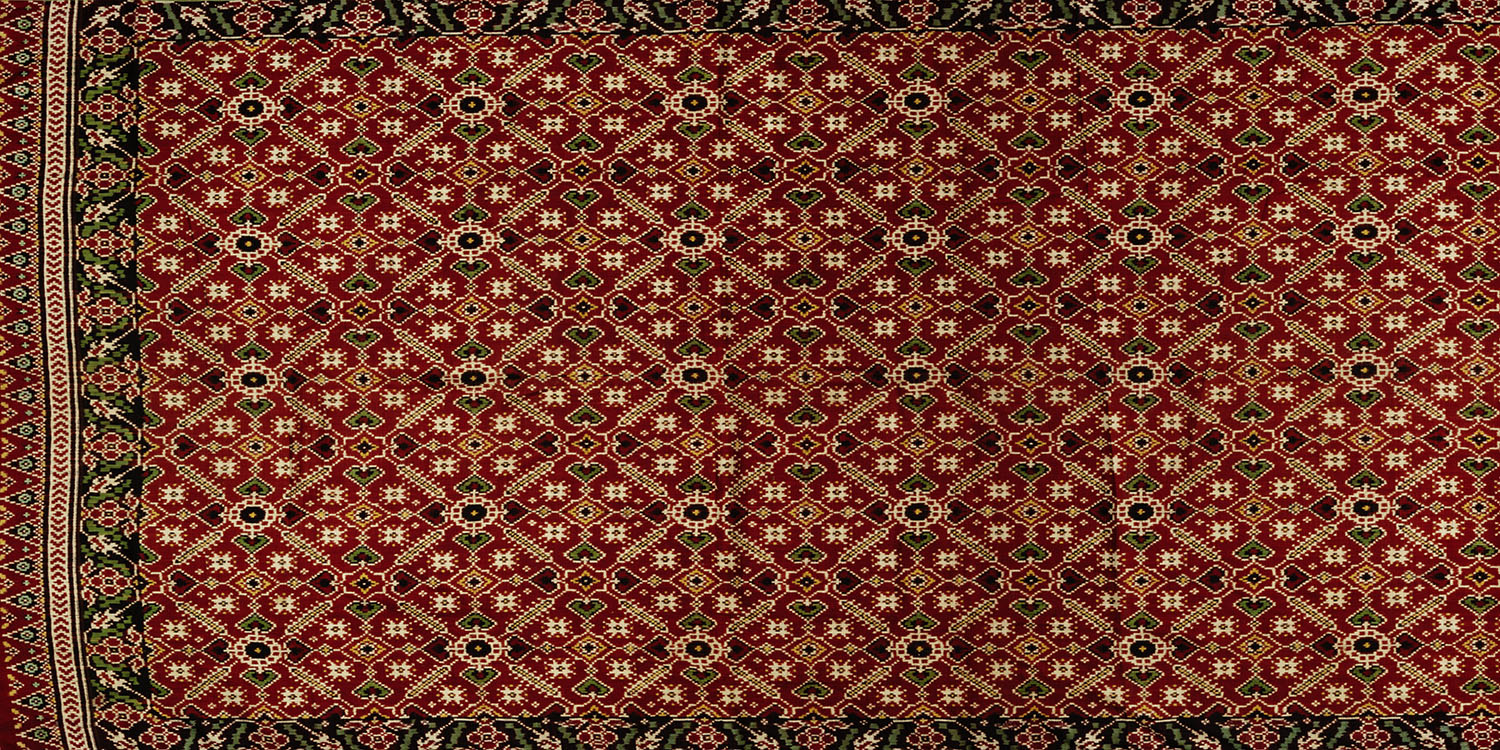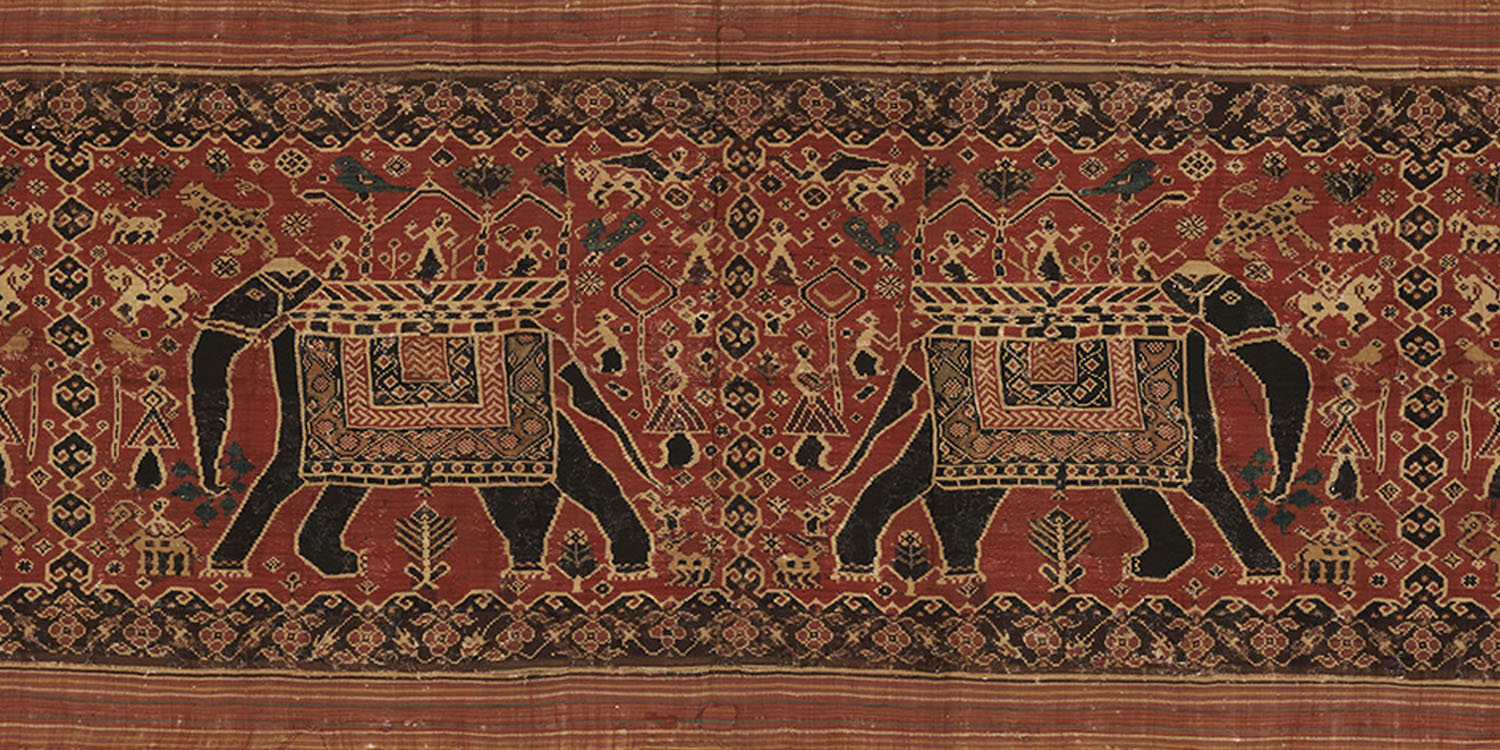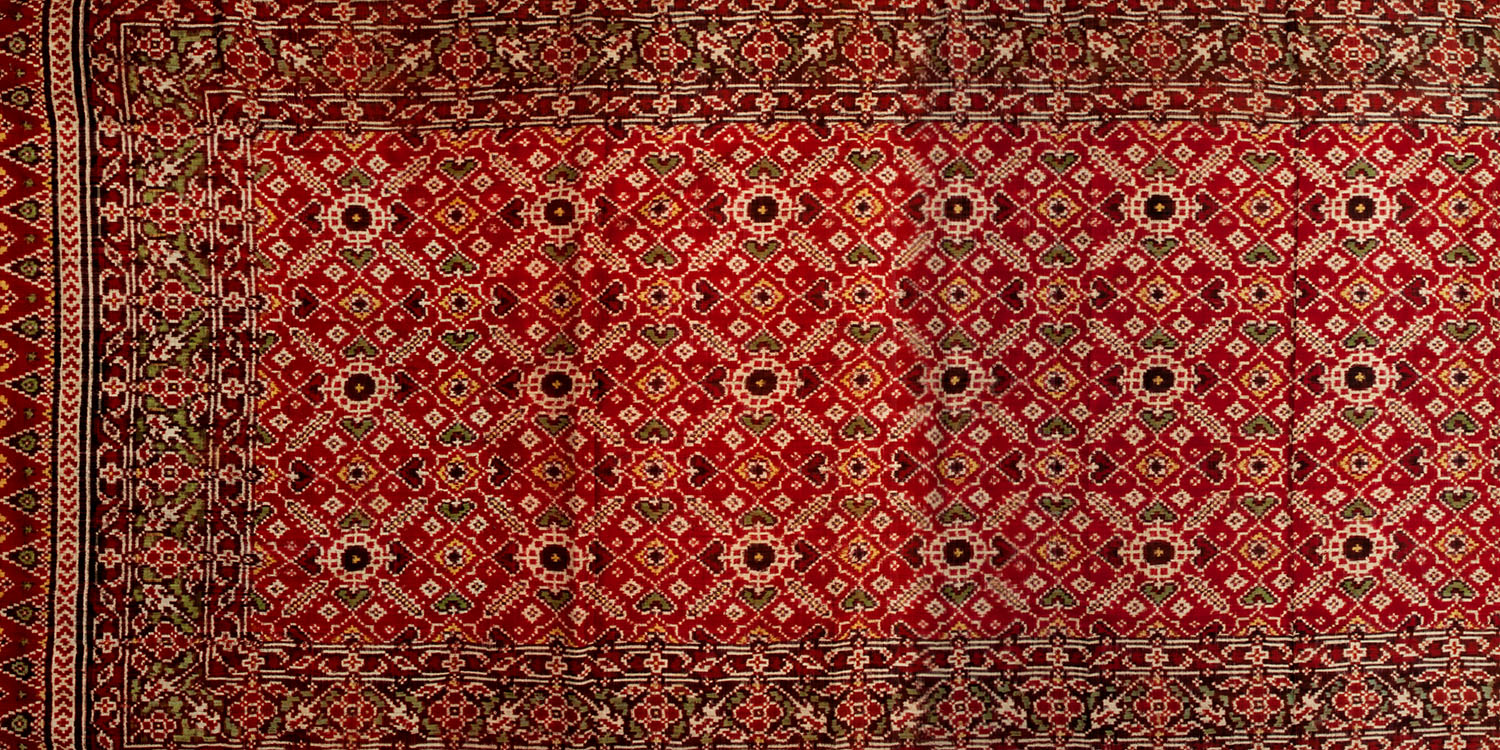ARTICLE
Patan Patola
Double ikat textiles woven in silk with meticulous attention to detail, Patan patola are named after the town of Patan in Gujarat, where they are woven. Historically, these fabrics were highly coveted in parts of India and Southeast Asia. Known for their masterful weaving, sharply defined patterns with geometric layouts and richly dyed colours, patola are considered to have social and ritual significance in several communities and regions.
While evidence of ikat patterns can be found on the mural paintings of the Ajanta caves, the origins of the double ikat technique in India, and specifically in Patan, remain unclear. Certain terms similar to patola – such as patalika, patakula vastrani – have been identified in Indian literature dating to the fourth century BCE, fifth century CE and tenth century CE, but historians believe these associations do not provide an established reference of patola as it is known or made today.
Firmer evidence of the Patan patola appears in the sixteenth century, in the form of accounts by European travellers such as Alfonso d’Albuquerque and Duate Barbosa, who referred to these fabrics in the context of the spice trade with Southeast Asia. A description of patola and their source of origin comes from an account by the seventeenth-century French traveller, Jean Baptiste Tavernier, who states that the silks were being manufactured in Ahmedabad. In historical literature, Ahmedabad, Patan, Baroda, Bharuch, Surat and Cambay are noted as centres of patola. However, historians believe that the mentions of Surat and Cambay may have been due to their importance as ports from which the fabrics were shipped, rather than as centres of weaving. The Salvis, the community who process and weave patola, link their own history to Jalna, a town in present-day Maharashtra, which was also a centre of patola until about the 1930s. However, the chronology of when and how the Salvi community arrived in Patan and began weaving patola remains unclear. Currently, Patan is the sole centre in India to follow the traditional patola weaving technique, although imitation patola, made mostly in single ikat and in both cotton and silk, are also woven and sold in Rajkot, Gujarat and Pochampally, Telangana.
Outside Gujarat, the cultural influence of patola can be seen most prominently in present-day Indonesia and in the Indian state of Kerala. Indian textiles possessed considerable economic value as trade goods in Southeast Asia, even before the arrival of colonial enterprises, such as the Dutch East India Company (DEIC). The DEIC, which supplied both cotton chintz from Coromandel, as well as cotton and patola from Gujarat, augmented the value of the silk textiles by gifting them to rulers on the islands and a few high-ranking individuals. In this way, patola textiles became markers of status and patola fabrics – known as chindé – began to be used as material for sewn garments, royal bedspreads, shoulder cloths, sashes and belts. Soon, restrictions were placed on who could wear patola textiles. In the Javanese courts of Yogyakarta and Surakarta, for instance, only the rulers, nobility and high-ranking officials were allowed to wear patola fabrics, with the sole exception being a bride and groom on their wedding day. Certain patola patterns, or local designs inspired by patola, were reserved for the exclusive use of ruling families, such as in 1769, when the ruler of Surakarta reserved the use of the jlamprang motif for his family.
Patola textiles also gained ritualistic importance. They were used as hangings in temples in Bali, as sacred textiles in the Central Celebes, and even as burial shrouds, coffin covers and talismanic fabrics in other local cultures. In Bali, small pieces of the textile were burned in traditional healing rituals. Patola also influenced the design of Indonesian textiles, which borrowed not only patterns such as the jlamprang, but also the composition and structure of a patolu, with its demarcated end pieces, main field and frames. Detailed patola-like designs were also made using the tulis batik technique. The demand for patola spurred the production of imitations, both locally and from India, where patola patterns block printed on cotton were produced for the trade market.
Patola made for Southeast Asian markets were not necessarily always of sari length or composition. The textiles had varied uses, including as hip wrappers, shoulder cloths, trousers and wall hangings. Material for sewn garments was sold as pattern pieces and the dimensions varied according to the intended use. The quality of the finished textile, too, was different. The silk used for export textiles tended to be heavier and coarser and the textiles, which often had cotton borders, were more loosely woven compared to those meant for the domestic market. Certain patterns were also made for the Indonesian market. These included the elephant pattern, similar to a pattern locally known as shrikar bhat, an elephant-and-tiger pattern in a grid, and variations of the chhabdi bhat. Another important motif was the tumpal (or row of triangles) in endpieces.
Patola were likely introduced to Kerala through trading routes. Here as well, as in Indonesia, they became associated with rulers and assumed ritual significance. The earliest visual documentation of patola in Kerala was in the form of the images published by HT Harris in 1908 of the collection within the Trivandrum Palace. However, the presence of patola patterns in murals at several palaces – including Padmanabhapuram Palace and Mattancherry Palace – and temples in Kerala indicates an older historical association. In these murals, Hindu deities were depicted wearing garments of patola designs or the motifs were used as backgrounds. The stepped-design of patola motifs can also be found in Theyyam shrines, where it is locally known as virali dalan.
In Gujarat, although they are considered auspicious, patola are not used by all communities as wedding saris to be worn by the bride. In some communities, a patolu piece may be used as an odhani by the bride, while in others bridegrooms drape a patolu around their upper body during the rituals. A patolu may also be used as a wedding cover draped on the bridegroom’s horse. Among the Bohra Muslims, who were also involved in the historical trade of patola textiles, these fabrics are a sign of the family’s social status during events such as weddings, where they are worn by the mothers of the bride and groom. Bohra Muslims also have their own unique patola pattern known as Bohra gaji bhat, in which the main field is filled with rows of gem-like shapes and motifs such as leaves, stylised creepers and stars.
The patola trade with Indonesia declined sharply after the Second World War. The laborious process of production has also affected the tradition, forcing many in the community to move to more lucrative and less intensive work. While a single patolu may be sold at upwards of INR 200,000 (USD 2000), it may take several months, sometimes even a full year, to weave. Given these constraints, the weaving of patola textiles has also expanded outside the Salvis, with workers and weavers from other communities also taking up the business.
The Geographical Indications (GI) tag for patola textiles became a subject of conflict between the Salvi weavers of Patan and the weavers in Rajkot. However, in 2013, it was finally awarded to the Patan patola.
Bibliography
Bannerjee, Poulumi. “Needed: Weavers for Patan Patola.” Hindustan Times, November 18, 2018. https://www.hindustantimes.com/india-news/needed-weavers-for-patan-s-patola/story-cYsccZW7WOMws3E0rId9wJ.html
Buhler, Alfred, Eberhard Fischer and Marie-Louis Nabholz. Indian Tie-Dyed Fabrics. Ahmedabad: Calico Museum of Textiles, 1980
Chishti, Rta Kapur and Rahul Jain. Handcrafted Indian Textiles. Edited by Martand Singh. Delhi: Roli Books, 2000.
Crill, Rosemary. Indian Ikat Textiles. London: V&A Publications, 1998.
Gupta, Rupam Singh. “Geographical indication tag to Patan patola to end feud over name.” Times of India, February 15, 2014. https://timesofindia.indiatimes.com/city/surat/geographical-indication-tag-to-patan-patola-to-end-feud-over-name/articleshow/30414891.cms
Gittinger, Mattiebelle. Splendid Symbols: Textiles and Tradition in Indonesia. Singapore: Oxford University Press, 1990.
Guy, John. Woven Cargoes: Indian Textiles in the East. London: Thames and Hudson, 1998.
Guy, John S. “Cloth for the gods – the Patola trade to Kerala.” Asian Art and Culture 9, no. 2 (1996): 27–37.
Krishnan, Gauri Parimoo. “Indian Trade Textiles: Transition in patronage, transformation in style.” Mapping India: Traditions and Transformations, 18th–19th century. Edited by Sutapa Dutta and Nilanjana Mukherjee. Oxon: Routledge, 2010.
Nambiar, Balan and Eberhard Fischer. “Patola/Virali pattu – from Gujarat to Kerala:
new information on double Ikat textiles in
South India.” Asiatische Studien/Études Asiatiques 41 (1987): 120–146. https://www.e-periodica.ch/cntmng?pid=ast-002:1987:41::214









